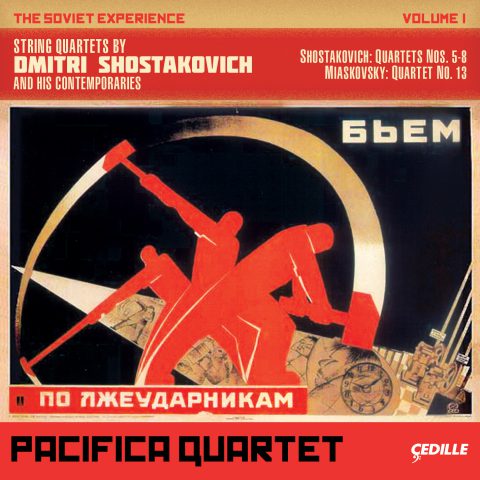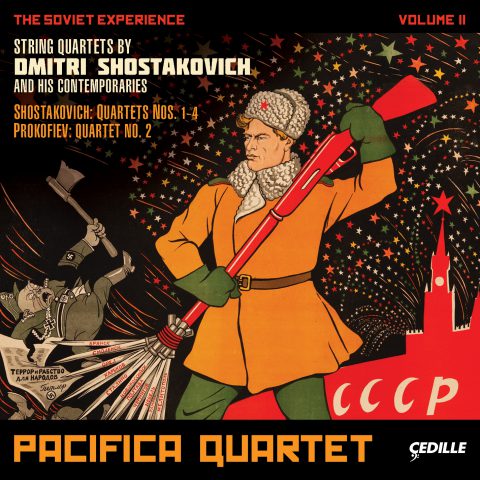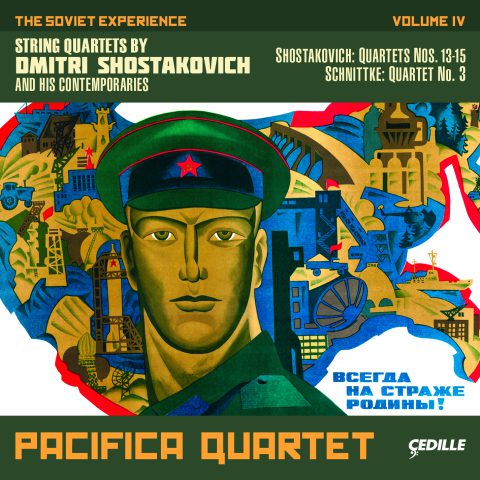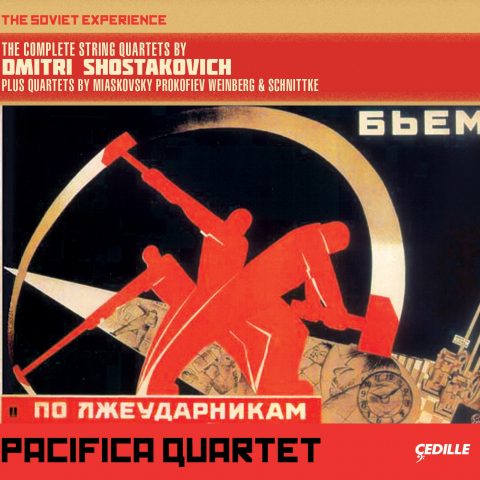Store
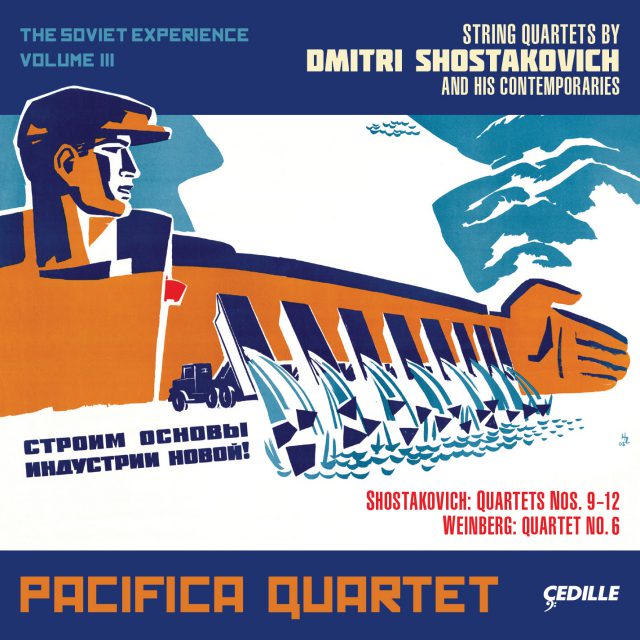
Store
The Soviet Experience Volume III: String Quartets by Dmitri Shostakovich and his Contemporaries
This is the third installment in the Pacifica Quartet’s highly anticipated, and already highly acclaimed four-volume CD survey of the complete Shostakovich string quartets: The Soviet Experience: String Quartets by Dmitri Shostakovich and his Contemporaries.
The Soviet Experience Volume III features Shostakovich’s String Quartets Nos. 9–12 from the 1960s. The Ninth Quartet’s five continuous movements build to a colossal finale. The Tenth has a classically balanced, four movement layout. The Eleventh’s seven continuous movements present a series of character sketches. The Twelfth brilliantly juxtaposes atonal and tonal themes to produce a cohesive and powerfully compelling whole. These quartets are paired with Mieczyslaw Weinberg’s adventurous, symphonic-scaled String Quartet No. 6 of 1946, an inventive work once banned in the Soviet Union for being ahead of its time. Weinberg was a close friend and colleague of Shostakovich.
The Pacifica’s previous installment, The Soviet Experience Volume II, received an extraordinary reception from critics. The Telegraph of London said, “The playing is nothing short of phenomenal, bringing new dimensions of interpretative depth and a subtle fusion of intensity and clarity. . . . When the series is complete, it looks set to be the one to own.” Luxembourg’s Pizzicato magazine gave the CD a rare “Supersonic” rating. The Boston Globe said the Pacifica radiates “a wedding of youthful electricity and interpretive insight.”
Preview Excerpts
DMITRI SHOSTAKOVICH (1906–1975)
String Quartet No. 9 in E-flat major, Op. 117
String Quartet No. 10 in A-flat major, Op. 118
String Quartet No. 11 in F minor, Op. 122
Artists
Program Notes
Download Album BookletDmitri Shostakovich and Mieczyslaw Weinberg Quartets
Notes by David Fanning
In the context of a new, supposedly egalitarian society, whose official cultural values stressed accessibility, folklorism, heroism, and immediacy, Soviet composers of string quartets had something of a struggle on their hands. Yet thanks to their training and tradition, enough of those composers retained their commitment to the genre that it survived. Indeed, it did more than survive, since that fraught context provided fuel — at times highly unstable — for the likes of Shostakovich, Weinberg, and Schnittke to infuse it with existential dramatic qualities, of the kind their Western counterparts had to create by and large from scratch.
Shostakovich’s cycle of 15 quartets (there would have been 24 in all the different keys, had he lived longer) spans nearly 40 years — from 1938 to 1974 — and is the undisputed monument in this unique tradition. Yet the 17 of Mieczys?aw Weinberg (1919–1996) have recently emerged as a powerful and fascinating complementary venture. This Polishborn pianist-composer, who twice had narrow escapes from Nazi invading forces, became a firm friend of Shostakovich’s from the time he settled in Moscow in 1943 until the older man’s death in 1975. During these years, each regularly showed the other his latest work. Weinberg discovered his individual voice thanks to his encounters with Shostakovich’s Fifth Symphony and a number of key chamber works (the Cello Sonata, Piano Quintet, and Second Piano Trio). But the debt was at least partially repaid, since the Jewish element in Shostakovich’s style is strongly impregnated with that of Weinberg’s, and a number of specific gestures in Shostakovich’s quartets are direct borrowings from Weinberg.
Several of Shostakovich’s 15 quartets invite consideration as pairs: Nos. 4 and 5, for instance, as ambitious post-war works that had to await the death of Stalin before they could be premiered; or Nos. 7 and 8, composed in quick succession in 1960, both of which are strikingly compact and to varying degrees autobiographical. Quartets 9 and 10 form another such pair. They were products of a burst of activity in 1964. The relatively unproductive spell of the years following the Eighth Quartet had seen an abandoned attempt at a Ninth Quartet (the score of a completed movement, rediscovered in the family archive, was first performed in Moscow by the Borodin Quartet in January 2005).
The first four of the five continuous movements of the Ninth are all somewhat constrained, building up tension for a colossal out-pouring of energy in the 719-bar summatory finale. Those first four movements explore some of Shostakovich’s most characteristic modes of expression. Anxious circling and a kind of crippled polka alternate in the opening Moderato, which, as in so many of Shostakovich’s first movements in the second half of his career, has a disquieting provisional quality. The quiet, nervy figure on the first violin that is heard seven times in the later stages of this movement is destined for great things later in the work. Much slowed down, its repeated notes usher in the elegiac meditation of the following Adagio. Slightly modified, the idea turns into the manic klezmer style of the Allegretto and then into the catatonic standstill of the Adagio fourth movement. All of these characters are then swept up in the maelstrom of the finale, where the seed-motif sets the seal on the defiant last pages. Like the finale of Shostakovich’s Eighth Quartet, this movement is a fugue, but this time one that supplies a massive energizing counterpart to the existential angst of its predecessor.
An extra-musical rationale for the Ninth Quartet’s drive towards affirmation might be found in the new stability Shostakovich was enjoying in his personal life after a decade of turmoil. This was thanks to his third wife, Irina Antonovna, whom he married in 1962 and who would support him resolutely through the progressive infirmities of his last years. Indeed, the Ninth Quartet carries a dedication to her. It was premiered, along with No. 10, by the Beethoven Quartet on November 20, 1964.
Part of the credit for the “creative diarrhea” (Shostakovich’s words in a letter to his friend Isaak Glikman) that produced the Ninth and Tenth Quartets must go to Weinberg. Specifically, it was the urge to surpass him, since Weinberg had reached his Ninth Quartet the previous year, and Shostakovich openly referred to a friendly “quartet contest” between the two. It is to Weinberg that the Tenth is dedicated. Shostakovich composed most of the work at an artists’ retreat in Dilizhan, in the mountains of Armenia.
Although the Ninth and Tenth Quartets are both large-scale works and may be counted among Shostakovich’s “symphonic” quartets, they are very different in design. Where the five continuous movements of No. 9 are weighted towards its colossal summatory finale, the Tenth is more classically balanced in its four-movement layout. It is almost as if Shostakovich decided to demonstrate what could still be done within the standard mold, at a time when many younger Soviet composers, including some of his own pupils, were eagerly lapping up the newly available delicacies of Western modernism.
As with the Ninth Quartet, the Tenth’s gently-paced first movement has a guarded, watchful feel, constantly seeking refuge in the warm shelter of plagal cadences (sub-dominant to tonic (or IV-I) progression also known as the “Amen cadence”). The viola’s sul ponticello triplets toward the end of the movement register as a shiver of anticipation. Then, as though unleashing forces the first movement dared not confront, the second movement is an outpouring of venom unparalleled in Shostakovich’s quartets; also unique are its heading, Allegretto furioso, and the substantial passage of unison writing for the two violins. The shock of this outburst is to some extent absorbed by a lamenting passacaglia slow movement, which at one point seems to glimpse light at the end of the tunnel. This leads without a break into an initially chugging, then sardonic finale that will eventually recall both the passacaglia and first movement themes, maintaining emotional instability up to the last page.
The Eleventh Quartet was first presented at a chamber concert of Shostakovich’s music in Leningrad on May 28, 1966. It was so well received that it had to be encored. Later that same night, the composer suffered his first heart attack. The works he composed after this event, such as the Second Cello Concerto, are generally viewed as marking the start of Shostakovich’s late style. However, much of the language in which that style would be couched is already extant in the Eleventh Quartet, which stands at the threshold of that uniquely bleak and discomfiting world.
Composed rapidly in January 1966, the Eleventh Quartet’s seven continuous movements constitute a unique structure for Shostakovich (he seems to have taken a decision after No. 8 that each of his succeeding quartets would have a different number of movements). Compact though the movements are, they do not feel like condensed versions of longer time-spans, as do the three movements of his even briefer Seventh Quartet. Nor do they form a succession of unconnected thumbnail sketches, as do the Aphorisms for piano, from his avant-garde youth. Instead, they present cryptic character-studies, or rather character snapshots, tenuously unified by the motif first heard at the cello’s first entry and then again in a quasi-chorale midway through the “Introduction,” as the first movement is styled.
This motif supplies the melodic outline for the succeeding, wiry Scherzo, and it resurfaces at intervals through the rest of the work. It appears as a brief moment of spiritual consolation in the third movement — an otherwise convulsive affair that puts a gruesomely sardonic spin on the title, Recitative. The following Etude uses a chorale texture to offset one of the most characteristic textures of Shostakovich’s late works: a frantic, yet non-directional, perpetual motion, suggestive of a brain racing while the body is crippled.
The Eleventh Quartet is dedicated to the memory of the second violinist of the Beethoven Quartet, Vasily Petrovich Shirinsky, who had died the previous summer. And it pays him a sly tribute. Having given practically all the thematic interest in the first four movements to the first violin, Shostakovich finally calls attention to the second violin in a Stravinskian Humoresque, casting him in the role of a mechanical cuckoo. The following Elegy, which follows the pattern of numerous Shostakovich’s slow movements by forming itself into something close to a passacaglia, makes partial amends by twice letting the second violin have the espressivo lamenting theme, before returning the instrument to its conventional filling-in role in the Conclusion, which sadly reviews themes from the Introduction and Scherzo.
The last ten years of Shostakovich’s life were dogged by ill health. In September 1967, he broke his right leg in a fall, as a consequence of the mysterious degenerative disease that had plagued him for nearly a decade; this was later tentatively diagnosed as a form of polio and later still, definitively, as motor neuron disease (better known as ALS or Lou Gehrig’s disease). A second heart attack followed in 1971, and the proximate cause of his death was lung cancer. These infirmities necessitated long periods of inactivity in hospitals and sanatoria. Not surprisingly Shostakovich’s thoughts turned increasingly to the topic of mortality, as his choice of texts for song-settings in these years confirms.
Coincidentally or not, this was also the period when he started to work with twelve-tone themes. He was not attempting to emulate or even build on the famous method established in the early-1920s by Schoenberg, for whose music and attitudes he had expressed some enthusiasm 40 years previously as a student but which later left him cold. Rather, Shostakovich was looking back to an earlier tradition of using twelve-tone themes and chords to represent some kind of absolute, often inimical quality, such as the reckless thirst for power and knowledge (as in Liszt’s Faust Symphony, Strauss’s Also sprach Zarathustra, and Berg’s Wozzeck). In Shostakovich’s case, the prime association is clearly with Death, as exemplified by his Fourteenth Symphony (1969) — comprised of settings of eleven poems on this topic positively saturated with twelvetone themes.
The sinuous solo cello opening of the Twelfth Quartet (composed in early 1968 and dedicated to Dmitry Tsyganov, first violin in the Beethoven Quartet) is one such theme, covering all twelve notes of the chromatic scale without repetition or recursion, and in this case without rhythmic or dynamic differentiation. Its polar opposite comes 25 minutes later with the Quartet’s concluding bars, which assert an unequivocal D-flat major in a fast, energetic fortissimo for all four instruments. To conclude from this that the Quartet is essentially a progression from Death to Life, symbolized by the move from atonality to tonality, would be too simple-minded. But it is certainly much concerned with the relationship between musical polarities. This is immediately suggested by the continuation of the cello’s opening gambit, which unwinds pure D-flat major scale patterns from the initial 12-tone theme. And taken together, the Quartet’s two movements clearly present a journey from torpor to physical assertiveness. As with the Ninth Quartet, this journey can be understood symbolically as a return to creative vigor — sentendo nuova forza, as Beethoven styled the contrasting sections of the famous Heiliger Dankgesang slow movement of his Op.132 Quartet. In general, the instrumental theatre of Beethoven’s late string quartets is the single most important precursor for Shostakovich’s cycle.
Characteristically for his later works, the opening movement of the Twelfth Quartet has a tentative, provisional quality, oscillating between the brooding material of the opening and a slightly faster would-be waltz led off by the first violin, also built around twelve-tone themes. The massive second movement begins as a gritty Scherzo with Janácekian trills, extensively worked out and overflowing into a manic Trio section in which twelve-tone scale-segments are thrown wildly between the instruments. Condensed repetitions of Scherzo and Trio eventually collapse, via a low-lying cello monologue, into a funereal slow section (virtually a movement within a movement) whose middle section is overlaid with a return of material from the first movement (starting with the first violin’s determined pizzicati). First movement themes then return, apparently untrammelled, and eventually some kind of peaceful coexistence with the Scherzo seems to be in prospect. Instead, the friction between them ignites into fiery intensity, leading to one of the rare unequivocally assertive conclusions in Shostakovich’s lateworks.
As with Shostakovich’s first five string quartets, the first six of Weinberg show a progressive expansion of artistic horizons — literally in that Nos. 3, 4, 5, and 6 are in three, four, five, and six movements, respectively (the pattern would be broken with No. 7). Composed in July and August 1946, the Quartet No. 6, Op. 35, comes at the highpoint of Weinberg’s extraordinary outpouring of chamber works during his first years in the Soviet Union. He dedicated the work to Georgy Sviridov, one of Shostakovich’s favorite pupils who was on the way to a starry career in vocal and choral music. Sviridov’s anti-Semitism, there for all to read in his posthumously published diaries, appears not to have affected their friendship: a signed photograph of Sviridov was a permanent fixture on Weinberg’s desk.
Weinberg’s Sixth Quartet figured in the infamous list of “nonrecommended” works promulgated in February 1948 as one consequence of the “anti-formalist” campaign spearheaded by Andrey Zhdanov. Though that ban was soon lifted, it left its mark on Weinberg: it would be nine years before he ventured back to the quartet medium. One plausible reason for the work’s suppression is simply that the Sixth Quartet was Weinberg’s most recent significant piece, and that to allow the premiere of an important work by a named formalist might have seemed an endorsement — a risky proposition for an official who might then find himself held to account. Another possible explanation for the ban is the Quartet’s strikingly ambitious and exploratory nature, which places greater demands on the listener than any of Weinberg’s previous quartets, even greater than any of Shostakovich’s. Indeed, it may well have stimulated the phenomenal invention and emancipated structures of Shostakovich’s Fourth and Fifth Quartets, composed three and six years later, respectively.
Weinberg’s Sixth Quartet is on a symphonic scale, and its overall design — three fast movements, a slow fugue, and two moderately paced concluding movements — is as flexible as that of the individual movements themselves. In terms of texture, Weinberg takes the transparency he had already achieved in the quartet medium one step further. On this occasion there is also a faint whiff of klezmer — the Jewish folk-dance idiom — to lend memorability to the opening Allegro semplice. The patiently unfolded central accumulation of this movement suggests lessons well learned from Shostakovich’s Second Quartet and the finale of his Second Piano Trio. The wildness that whips up the development section through manic glissandos to an extended fff climax is taken up again in the succeeding Presto agitato, a movement cut from the same cloth as Shostakovich’s Second and Third Quartets. In its startling extremes and brevity, the immediately succeeding Allegro con fuoco predicts the instrumental theatre of later Shostakovich quartets — not altogether surprising, given that both composers clearly shared historical roots in the disruptive violence of late Beethoven.
Weinberg’s central Adagio goes to the opposite extreme, with a quietly purposeful, orthodox fugal exposition, an intricate stretto by diminution, and an eventual recall of the declamations of the preceding Allegro con fuoco, punctuated by rhetorical outbursts and moments of catatonic stasis. This is followed by a healing Moderato commodo that reserves some col legno Prokofievian tick-tock accompaniment figures — highly effective in their spectral character — for the later stages, before renewed, painfully passionate outbursts are pacified in an ethereal conclusion. The final Andante maestoso has terrific strength in reserve and develops an unstoppable momentum, as if determined to rectify the Quartet’s numerous structural and emotional imbalances. However, even this movement has a moment of craziness towards the end, when an episode of trivial dancing music intrudes on the more serious business. Overall, this is a deeply unsettled score, one of Weinberg’s most experimental for the time, and a highpoint in his first maturity as a composer. It is easy to understand why it was not performed at the time of composition. Although the score was eventually published in 1979, the January 24, 2007 performance by the Quatuor Danel at the University of Manchester is believed to have been the world premiere.
Album Details
Total Time Disc One: 70:20
Total Time Disc Two: 58:25
Producer and Engineer: Judith Sherman
Assistant Engineer & Digital Editing: Bill Maylone
Shostakovich Quartet No. 9 Editing: James Ginsburg
Recorded: Shostakovich Quartets No. 9–11: January 12–13 and January 31–February 1, 2012; Shostakovich Quartet No. 12: May 14–15, 2012 — Foelinger Great Hall, Krannert Center, University of Illinois at Champaign-Urbana
Microphones: Sonodore RCM-402 & DPA 4006-TL
Front Cover Art: Building the Foundation of a New Industry!, 1969, by Nikolai Petrovich Charuhin (1934–2009), available at www.sovietposters.ru
Inside Booklet & Inlay Card Design: Nancy Bieschke
Weinberg Peermusic Classical — String Quartet No. 6, Op. 35 © 1946
Shostakovich G. Schirmer Inc. — String Quartet No. 9, Op. 117 © 1964; String Quartet No. 10, Op. 118 © 1964; String Quartet No. 11, Op. 122 © 1966; String Quartet No. 12, Op. 133 © 1968
© 2013 Cedille Records/Cedille Chicago
CDR 90000 138
